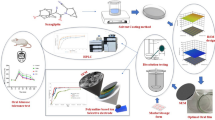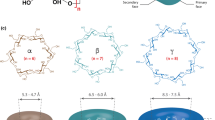Abstract
The objectives of this research were to prepare and characterize inclusion complexes of clonazepam with β-cyclodextrin and hydroxypropyl-β-cyclodextrin and to study the effect of complexation on the dissolution rate of clonazepam, a water-insoluble lipid-lowering drug. The phase-solubility profiles with both cyclodextrins were classified as AP-type, indicating the formation of 2:1 stoichiometric inclusion complexes. Gibbs free energy \( \left( {\Delta {G_{tr}}^o} \right) \) values were all negative, indicating the spontaneous nature of clonazepam solubilization, and they decreased with increase in the cyclodextrins concentration, demonstrating that the reaction conditions became more favorable as the concentration of cyclodextrins increased. Complexes of clonazepam were prepared with cyclodextrins by various methods such as kneading, coevaporation, and physical mixing. The complexes were characterized by Fourier transform infrared spectroscopy and differential scanning calorimetry studies. These studies indicated that complex prepared kneading and coevaporation methods showed successful inclusion of the clonazepam molecule into the cyclodextrins cavity. The complexation resulted in a marked improvement in the solubility and wettability of clonazepam. Among all the samples, complex prepared with hydroxypropyl-β-cyclodextrin by kneading method showed highest improvement in in vitro dissolution rate of clonazepam. Mean dissolution time of clonazepam decreased significantly after preparation of complexes and physical mixture of clonazepam with cyclodextrins. Similarity factor indicated significant difference between the release profiles of clonazepam from complexes and physical mixture and from plain clonazepam. Tablets containing complexes prepared with cyclodextrins showed significant improvement in the release profile of clonazepam as compared to tablet containing clonazepam without cyclodextrins.







Similar content being viewed by others
References
Skerritt JH, Johnston GA. Enhancement of GABA binding by benzodiazepines and related anxiolytics. Eur J Pharmacol. 1983;89(3–4):193–8.
Lehoullier PF, Ticku MK. Benzodiazepine and beta-carboline modulation of GABA-stimulated 36Cl-influx in cultured spinal cord neurons. Eur J Pharmacol. 1987;135(2):235–8.
Proudfoot S. Factors affecting bioavailability: factors influencing drug absorption from the gastrointestinal tract. In: Aulton ME, editor. Pharmaceutics: the science of dosage from design. Edinburgh: Churchill Livingstone; 1991. p. 135–73.
Pitha J, Milecki J, Fales H, Pannell L, Uekama K. Hydroxypropyl-β-cyclodextrin: preparation and characterization; effects on solubility of drugs. Int J Pharm. 1986;29:73–82.
Duchêne D. Cyclodextrins and their industrial uses. Editions de Santé Paris, 1987; SS. 447–460.
Baboota S, Agarwal SP. Rofecoxib complexation with β-cyclodextrin: influence on the anti-inflammatory and ulcerogenic activity. Die Pharmazie. 2003;58:73–4.
Fernandes CM, Teresa VM, Veiga FJ. Physicochemical characterization and in vitro dissolution behavior of nicardipine-cyclodextrins inclusion compounds. Eur J Pharm Sci. 2002;15:79–88.
Kamada M, Hirayama F, Udo K, Yano H, Arima H, Uekama K. Cyclodextrin conjugate-based controlled release system: repeated- and prolonged-releases of ketoprofen after oral administration in rats. J Control Release. 2002;82:407–16.
Mukne AP, Nagarsenker MS. Triamterene-β-cyclodextrin systems: preparation, characterization and in vivo evaluation. AAPS PharmSci Tech. 2004;5:article 19.
Uekama K, Otagiri M. Cyclodextrins in drug carrier systems. Crit Rev Ther Drug Carrier Syst. 1987;3:1–40.
Szejtli J. Medicinal applications of cyclodextrins. Med Res Rev. 1994;14:353–86.
Xianhong W, Ziyang L, Tianqiang Z. Mass spectrometry and molecular modeling studies on the inclusion complexes between α β-cyclodextrins and simvastatin. Chem Phys Lett. 2005;405:114–7.
Baboota S, Dhaliwal M, Kohli K. Physicochemical characterization, in vitro dissolution behavior, and pharmacodynamic studies of rofecoxib-cyclodextrin inclusion compounds. AAPS PharmSciTech. 2005;6:E83–90.
Ghorab MK, Adeyeye MC. Elucidation of solution state complexation in wet-granulated oven-dried ibuprofen and β-cyclodextrin: FT-IR and 1H-NMR studies. Pharm Dev Technol. 2001;6:315–24.
Veiga FJ, Fernandes C, Carvalho RA, Geraldes CF. Molecular modeling and 1H-NMR: ultimate tools for the investigation of tolbutamide: β-cyclodextrin and tolbutamide: hydroxypropyl-β-cyclodextrin complexes. Chem Pharm Bull. 2001;49:1251–6.
Tirucherai GS, Mitra AK. Effect of hydroxypropyl beta cyclodextrin complexation on aqueous solubility, stability, and corneal permeation of acyl ester prodrugs of ganciclovir. AAPS PharmSciTech. 2003;4:E45.
Nalluri BN, Chowdary KPR, Murthy KVR, Hayman AR, Becket G. Physicochemical characterization and dissolution properties of nimesulide-cyclodextrin binary systems. AAPS Pharm Sci Tech. 2003;4:E2.
Peeters J, Neeskens P, Tollenaere JP, Van Remoortere P, Brewster ME. Characterization of the interaction of 2-hydroxypropyl-betacyclodextrin with itraconazole at pH 2, 4, and 7. J Pharm Sci. 2002;91:1414–22.
Moore JW, Flanner H. Mathematical comparison of dissolution profiles. Pharm Tech. 1996;20:64–74.
Guidance for Industry SUPAC-MR: modified release solid oral dosage forms scale-up and postapproval changes: chemistry, manufacturing, and controls; in vitro dissolution testing and in vivo bioequivalence documentation. US Food and Drug Administration, Rockville, MD, USA, 1997. www.fda.gov/cder/guidance/index.html.
Human Medicines Evaluation Unit, EMEA. Notes for Guidance on Quality of Modified-Release Products; A Oral Dosage Forms; B Transdermal Dosage Forms, Section 1 (Quality) 1999.
Reppas C, Nicolaides E. Analysis of drug dissolution data. In: Dressman JB, Lennernäs H, editors. Oral drug absorption prediction and assessment. New York: Marcel Dekker; 2000. p. 229–54.
Vueba ML, Batista de Carvalho LAE, Veiga F, Sousa JJ, Pina ME. Influence of cellulose ether polymers on ketoprofen release from hydrophilic matrix tablets. Eur J Pharm Biopharm. 2004;58:51–9.
Higuchi T, Connors K. Phase solubility techniques. Adv Anal Chem Instru. 1965;4:17–123.
Szejtli J. Cyclodextrin inclusion complexes. In Cyclodextrin Technology. Dordrecht: Kluwer Academic Publishers; 1988. p. 101–2.
Peri D, Wyandt CM, Cleary RW, Hickal AH, Jones AB. Inclusion complexes of tolnaftate with β-Cyclodextrin and hydroxy-β-cyclodextrin. Drug Dev Ind Pharm. 1994;20:1401–10.
Labenderia JJT, Lopez ME, Penin LS, Jato JLV. Glibornuride-β-cyclodextrin inclusion complexes: preparation, structural characterization, and in vitro dissolution behavior. J Pharm Biopharm. 1993;39:255–9.
Chengsheng L, Chenguang L, Kashappa HD. Enhancement of dissolution rate of valdecoxib using solid dispersions with polyethylene glycol 4000. Drug Dev Ind Pharm. 2005;1:1–10.
Bloch DW, Elegakey MA, Speiser PP. Solid dispersions of chlorthalidone in urea. Pharm Acta Helv. 1982;57(8):231–5.
Loftsson T, Brewster EM. Pharmaceutical application of cyclodextrins. 1. drug solubilization and stabilization. J Pharm Sci. 1996;85:1017–25.
Uekama K, Hirayama F, Otagiri M, Ikeda K. Inclusion complexation of cyclodextrin with some sulfonamides in aqueous solution. Chem Pharm Bull. 1978;26(4):1162–7.
Moyano JR, Arias-Blanco MJ, Gine’s JM, Giordano F. Study of the complexation behaviour of gliclazide with partially methylated b-cyclodextrin in solution and solid state. Int J of Pharm. 1997;157:239–43.
Hedges AR. Industrial applications of cyclodextrins. Chem Rev. 1998;98:2035–44.
Serajuddin ATM, Sheen PC, Augustine MA. Improved dissolution of poorly water soluble drug from solid dispersions in polyethylene: polysorbate 80 mixture. J Pharm Sci. 1990;79:463–4.
Barzegar-Jalali M, Maleki N, Garjani A, Khandar AA, Haji-Hosseinloo M, Jabbari RC, et al. Enhancement of dissolution rate and anti-inflammatory effects of piroxicam using solvent deposition technique. Drug Dev Ind Pharm. 2002;28:681–6.
Tang L, Khan SU, Muhmmad NA. Evaluation and selection of bio-relevant dissolution media for a poorly water soluble new chemical entity. Pharm Dev Technol. 2001;6:531–40.
Aulton ME. Pharmaceutical technology. In: Pharmaceutics: The Science of Dosage Form Design. London: Churchill Livingstone. 1988; 600–616.
Acknowledgment
We are thankful to Roquette Frères, France for the generous gift of HPβ-CD and β-CD. We would like to thank Centaur Chemicals Pvt. Ltd., Mumbai, India for donating Clonazepam. We would also like to thank Maan Pharmaceuticals Ltd. for providing formulation excipients. We are grateful to the Department of Pharmacy, M. S. University, India for conducting DSC studies of the samples.
Author information
Authors and Affiliations
Corresponding author
Rights and permissions
About this article
Cite this article
Patel, R., Purohit, N. Physico-Chemical Characterization and In Vitro Dissolution Assessment of Clonazepam—Cyclodextrins Inclusion Compounds. AAPS PharmSciTech 10, 1301–1312 (2009). https://doi.org/10.1208/s12249-009-9321-3
Received:
Accepted:
Published:
Issue Date:
DOI: https://doi.org/10.1208/s12249-009-9321-3




